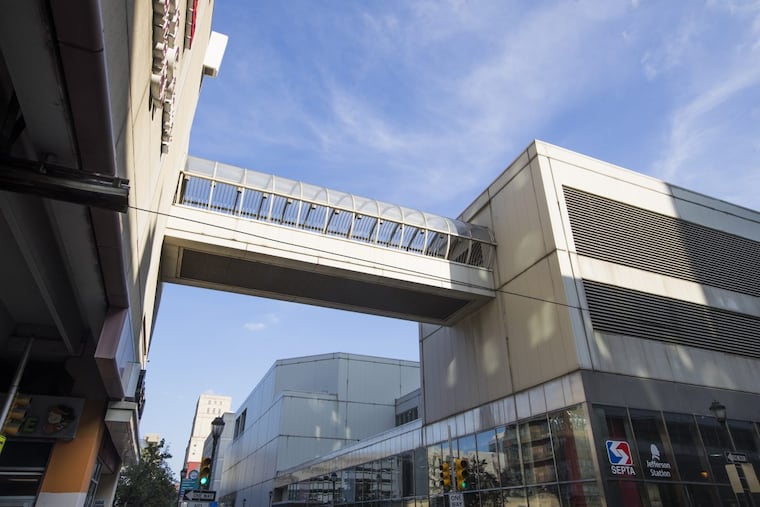Curtain is raised on movie multiplex plans at reborn Gallery mall
When the AMC multiplex opens, Center City cinema devotees will have a place to see first-run, mainstream movies on their home turf for the first time since 2002.

AMC Theatres thinks Center City is ready for the big screen. Eight of them.
The Leawood, Kan.-based theater chain plans to open an eight-screen multiplex in the reborn Gallery at Market East shopping mall, as central Philadelphia's growing population and affluence makes it the latest U.S. downtown to draw movie exhibitors' attention.
AMC's location at the Center City project, to be called Fashion District Philadelphia, will feature reclining chairs, food and drink for in-seat nibbling, and two auditoriums that support premium-format screenings, Dan Ellis, the company's senior vice president for domestic development, said Monday.
When the multiplex opens in late fall or early winter 2019, Center City cineastes will have a place to see first-run, mainstream movies on their home turf for the first time since 2002, when the Sameric Theatre (previously the Boyd) closed at 19th and Chestnut Streets.
Paul Sweeney, a media-industry analyst with Bloomberg Intelligence, said theater chains such as AMC are "slowly dipping their toes into center city areas" after focusing for decades largely on suburban locations, as once moribund urban areas are reborn.
"Movie theater exhibitors simply go where the population is," he said. "They think a growing population within city limits can support a multiplex."
The population of what the Center City District business group calls Greater Center City rose more than 16 percent to about 183,000 in 2014, from below 158,000 in 2000, shortly before the Sameric closed, according to U.S. census data compiled by the organization.
Average income in that area — bounded by the Schuylkill to the west, Spring Garden Street to the north, the Delaware River to the east, and Tasker Street to the south — soared about 67 percent, to $98,000, in that time, the data shows.
"Being in the heart of downtown Philadelphia in a dynamic kind of mixed-use Center City retail development is attractive to AMC," Ellis said.
The new urban multiplexes differ from the small one- and two-auditorium venues in city centers of decades past, said Sweeney, as theater operators revisit downtowns with compact versions of the many-screened movie complex they pioneered in sprawling suburbs.
Examples of recent urban multiplex projects include the independently operated Williamsburg Cinemas, which opened in Brooklyn, N.Y., in 2012 with seven screens, and the six-screen theater opened last month in downtown Bellevue, Wash., by Cinemark Holdings Inc. of Plano, Texas.
Imagine Entertainment Inc. of Troy, Mich., meanwhile, said it's scouting locations for a "megaplex" in downtown Detroit, Crain's Detroit Business reported in June.
The Center City theater complex planned by AMC, a unit of Beijing-based conglomerate Wanda Group, is to open on the third floor of the westernmost portion of the former Gallery mall, an area recently vacated when clothing discounter Burlington Stores Inc. moved to another part of the property.
Renovation for the theater space will involve raising the mall section's roof to accommodate the auditoriums' stadium seating, said Joseph Coradino, chief executive of Pennsylvania Real Estate Investment Trust, which is redeveloping the property with Macerich of Santa Monica.
One of those auditoriums will be a Dolby Cinema theater, with enhanced sound and screen brightness, Ellis said. The only other Dolby Cinema theater in the Philadelphia area that also features reclining seats that "pulsate with the action" is the AMC Neshaminy 24 in Bensalem.
Another of the eight auditoriums will be outfitted for the "Prime at AMC" format, which is similar to Dolby Cinema, but at a lower ticket price, Ellis said. The Prime format is currently featured at five theaters nationwide, including the AMC Marlton 8.
At the Fashion District multiplex, audience members will be able to order food when they arrive at the theater to be delivered to their seats, he said. Also planned is a MacGuffins Bar, the private-label watering hole that AMC installs at some theaters.
"There's a lack of real good, quality product in the area, in terms of the cinema experience," Ellis said. "By bringing in a brand new AMC theater, we feel like we can fill a void that's in the market now."
Coradino, meanwhile, cast the theater as a linchpin in the success of the Fashion District project, for which the only other new tenant to have been confirmed so far is clothing retailer H&M.
In addition to being accessible through the mall's interior, the theater complex will have a prominent designated entrance flanked by ground-floor, street-facing retail shops on Filbert Street along the mall's north side, helping PREIT achieve its goal of bringing life to the now-underutilized throughway, Coradino said.
"A key piece of the puzzle for Fashion District Philadelphia is now in place," he said of the theater. "We're psyched about it."